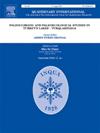非洲湿润期时空特征的多模式研究
IF 1.8
3区 地球科学
Q3 GEOGRAPHY, PHYSICAL
引用次数: 0
摘要
在过去的大约2万年里,非洲气候经历了与全球冰川消融和水分可用性变化有关的温度变化,这些变化定义了大约14800 - 5500年前的非洲湿润期(AHP)。然而,非洲各地气候的时空变化及其背后的机制仍然没有得到明确的定义和争论。在这里,我们首先基于9个地点的两种独立的特定地点建模方法,描述了热带非洲(15°N至15°S)在过去2万年中的气候变化特征,使用:(i)基于先前发表的9个花粉记录的花粉数据的基于概率的重建,以及(ii)基于地球系统机制模型的基于气候模拟的重建。在这两种模拟方法之间,发现每个站点过去的气候变化趋势是相似的;然而,与基于机制模式的重建相比,基于花粉的重建对降水的估计更高。考虑到两种建模方法在这些地点的总体相似性,我们随后使用机械模型绘制了非洲过去1000年时间片段的气候图。对该模型的质疑支持了先前的建议,即西部的AHP是由降水增加(约13000年前)驱动的。在研究区东部和南部,AHP信号更为复杂,可能是由不同气候机制之间的相互作用驱动的;非洲东部最潮湿的AHP条件直到大约9000年前才开始出现。本文章由计算机程序翻译,如有差异,请以英文原文为准。
A multi-model approach to the spatial and temporal characterization of the African Humid Period
During the last c. 20,000 years, African climates experienced temperature shifts related to the last period of global deglaciation and moisture availability changes that defined what has become known as the African Humid Period (AHP) c. 14,800–5500 years ago. However, spatio-temporal variations in climate, and the mechanisms behind them, across Africa remain poorly defined and debated. Here, we first characterize climatic change across tropical Africa (15°N to 15°S) over the last c. 20,000 years based on two independent site-specific modelling approaches at nine locations, using: (i) probability-based reconstructions based on pollen data from nine previously published pollen records, and (ii) climate simulation-based reconstructions based on mechanistic models of the Earth system. Trends in past climate change per site were found to be similar between the two modelling approaches; however, estimates of precipitation were higher in the pollen-based reconstructions when compared with those from the mechanistic model. Given the overall similarity between the two modelling approaches at the sites, we then used the mechanistic model to produce maps of past climate across Africa at 1000-year time slices. Interrogation of the model supports previous suggestions that the AHP in the west was driven by increasing precipitation (c. 13,000 years ago). In the eastern and southern portions of the study region, the AHP signal is more complex, likely driven by the interplay between different climate mechanisms; with the onset of the wettest AHP conditions in eastern Africa not commencing until c. 9000 years ago.
求助全文
通过发布文献求助,成功后即可免费获取论文全文。
去求助
来源期刊

Quaternary International
地学-地球科学综合
CiteScore
5.60
自引率
4.50%
发文量
336
审稿时长
3 months
期刊介绍:
Quaternary International is the official journal of the International Union for Quaternary Research. The objectives are to publish a high quality scientific journal under the auspices of the premier Quaternary association that reflects the interdisciplinary nature of INQUA and records recent advances in Quaternary science that appeal to a wide audience.
This series will encompass all the full spectrum of the physical and natural sciences that are commonly employed in solving Quaternary problems. The policy is to publish peer refereed collected research papers from symposia, workshops and meetings sponsored by INQUA. In addition, other organizations may request publication of their collected works pertaining to the Quaternary.
 求助内容:
求助内容: 应助结果提醒方式:
应助结果提醒方式:


